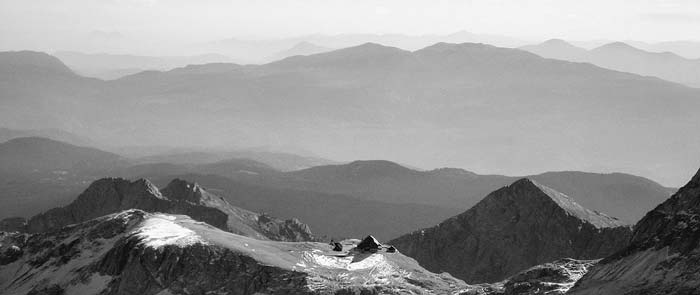
Vršič Pass • Soča River Valley • Bovec • Kobarid
Orientation to the Julian Alps
Map: The Julian Alps & Northwest Slovenia
Sleeping and Eating near Kobarid
The countryside around Lake Bled is plenty spectacular. But to top off your Slovenian mountain experience, head for the hills. The northwestern corner of Slovenia—within yodeling distance of Austria and Italy—is crowned by the Julian Alps (named for Julius Caesar). Here, mountain culture has a Slavic flavor.
The Slovenian mountainsides are laced with hiking paths, blanketed in deep forests, and speckled with ski resorts and vacation chalets. Beyond every ridge is a peaceful alpine village nestled around a quaint Baroque steeple. And in the center of it all is Mount Triglav—ol’ “Three Heads”—Slovenia’s national symbol and tallest mountain.
The single best day in the Julian Alps is spent driving up and over the 50 hairpin turns of breathtaking Vršič Pass (vur-SHEECH, open May-Oct) and back down via the Soča (SOH-chah) River Valley, lined with offbeat nooks and Hemingway-haunted crannies. As you curl on twisty roads between the cut-glass peaks, you’ll enjoy stunning high-mountain scenery, whitewater rivers with superb fishing, rustic rest stops, thought-provoking WWI sights, and charming hamlets.
A pair of Soča Valley towns watch over the region. Centrally situated Bovec is all about good times (it’s the whitewater adventure-sports hub), while Kobarid has Old World charm and better restaurants, and attends to more serious matters (WWI history). Though neither is a destination in itself, both Bovec and Kobarid are pleasant, functional, and convenient home bases for exploring this gloriously beautiful region.
Most visitors do this area as a surgical strike on a full-day side-trip from Lake Bled or Ljubljana—and even that quick glimpse is very satisfying. But I find that there’s enough here to make it worth slowing down and spending a night (or possibly more). If you’d like to take advantage of the Soča Valley’s many adventure sports (especially whitewater rafting on the Soča River), give yourself more time.
The Julian Alps are best by car. Even if you’re doing the rest of your trip by train, consider renting a car here for maximum mountain day-trip flexibility. I’ve included a self-guided driving tour that incorporates the best of the Julian Alps (Vršič Pass and the Soča Valley).
If you’re without your own wheels, hiring a local guide with a car can be a great value, maximizing not only what you see, but what you learn. Cheaper but less personalized, you could join a day-trip excursion from Bled. (Both options are explained under “Tours at Lake Bled,” here.)
In the summer, a public bus follows more or less the driving-tour route over the Vršič Pass described below (departs Ljubljana daily July-Aug at 6:30 and 15:00, June and Sept Sat-Sun only at 6:30, 4.25 hours to Bovec, afternoon bus also continues to Kobarid in 5 hours total, road closed Oct-May). Additional Vršič Pass buses leave from Kranjska Gora at the foot of the mountains, which is also connected by bus to Ljubljana and Bled. (Yet another option is to take a direct bus from Ljubljana to Bovec that uses the somewhat less scenic southerly route via Idrija—but then you’d miss going over the Vršič Pass.) To check or confirm schedules, see www.ap-ljubljana.si.
If you lack the time or transport to reach the Vršič Pass and Soča Valley, you could stay closer to Bled, and get a taste of the Julian Alps with a more convenient day trip to the Vintgar Gorge or Lake Bohinj (reachable with easy and frequent bus connections; see “Near Lake Bled” in the previous chapter).
This all-day, self-guided driving tour—rated ▲▲▲—takes you over the highest mountain pass in Slovenia, with stunning scenery and a few quirky sights along the way. From waterfalls to hiking trails, WWI history to queasy suspension bridges, this trip has it all.
Most of the Julian Alps are encompassed by Triglav National Park (Triglavski Narodni Park). This drive is divided into two parts: the Vršič Pass and the Soča River Valley. While not for stick-shift novices, all but the most timid drivers will agree that the scenery is worth the many hairpin turns. Frequent pull-outs offer plenty of opportunities to relax, stretch your legs, and enjoy the vistas.
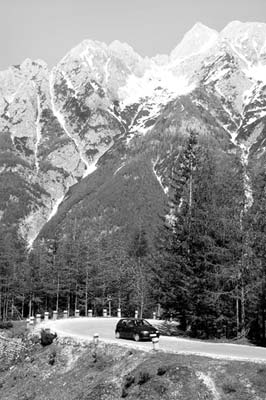
Planning Your Time: This drive can be done in a day, but consider spending the night along the way for a more leisurely pace. You can start and end in Bled or Ljubljana. You can return to your starting point, or do this trip one-way as a very scenic detour between these two destinations.
Length of This Tour: These rough estimates do not include stops: Bled to the top of Vršič Pass—1 hour; Vršič Pass to Trenta (start of Soča Valley)—30 minutes; Trenta to Bovec—30 minutes; Bovec to Kobarid—30 minutes; Kobarid to Ljubljana or Bled—2 hours (remember, it’s an hour between Ljubljana and Bled). In other words, if you started and ended in Bled and drove the entire route without stopping, you’d make it home in less than five hours...but you’d miss so much. It takes at least a full day to really do the region justice.
Tourist Information: The best sources of information are the Bled TI (see here), the Triglav National Park Information Centers in Trenta (here) and Bled (here), and the TIs in Bovec and Kobarid (both listed in this chapter).
Maps: Pick up a good map before you begin (available at local TIs, travel agencies, and gas stations). The all-Slovenia Autokarta Slovenija or the TI’s Next Exit: Goldenhorn Route map both include all the essential roads, but several more detailed options are also available. The 1:50,000 Kod & Kam Posoče map covers the entire Vršič Pass and Soča Valley (but doesn’t include the parts of the drive near Bled and Ljubljana).
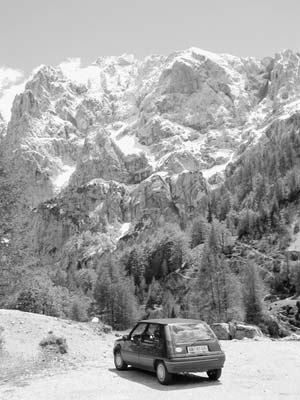
OK...let’s ride.
(See “The Julian Alps & Northwest Slovenia” map, here.)
From Bled or Ljubljana, take the A-2 expressway north, enjoying views of Mount Triglav on the left as you drive. About 10 minutes past Bled, you’ll approach the industrial city of Jesenice, whose iron- and steelworks once filled this valley with multicolored smoke. The city, which was known as the “Detroit of Yugoslavia,” plans to convert these old factories (most of which closed in the 1980s) into a sort of theme park.
Just after the giant smokestack with the billboards, the little gaggle of colorful houses on the right (just next to the freeway) is Kurja Vas (“Chicken Village”). This unassuming place is locally famous for producing hockey players: 18 of the 20 players on the 1971 Yugoslav hockey team—which went to the World Championships—were from this tiny hamlet.
As you zip past Jesenice, keep your eye out for the exit marked Jesenice-zahod, Trbiž/Tarvisio, Kr. Gora, and Hrušica (it’s after the gas station, just before the tunnel to Austria). When you exit, turn left toward Trbiž/Tarvisio and Kranjska Gora (yellow sign).
Just after the exit, the big, blue building surrounded by tall lights was the former border station (the overpass you’ll go under leads into Austria). Locals have fond memories of visiting Austria during the Yugoslav days, when they smuggled back forbidden Western goods. Some items weren’t available at home (VCRs, Coca-Cola, designer clothes), while other goods were simply better in Austria (chocolate, coffee, dishwasher soap).
Slovenes brag that their country—“with 56 percent of the land covered in forest”—is Europe’s second-greenest. As you drive toward Kranjska Gora, take in all this greenery...and the characteristic Slovenian hayracks (recognized as part of the national heritage and now preserved; see here). The Vrata Valley (on the left) is a popular starting point for climbing Mount Triglav. Paralleling the road on the left is a “rails-to-trails” bike path—converted from an old railway bed—that loops from here through Italy and Austria, allowing bikers to connect three countries in one day. On the right, watch for the statue of Jakob Aljaž, who actually bought Triglav, back when such a thing was possible (he’s pointing at his purchase). Ten minutes later, in Gozd Martuljek, you’ll cross a bridge and enjoy a great head-on view of Špik Mountain.
Kranjska Gora was once Yugoslavia’s leading winter resort, and remains popular with Croatian skiers. As every Slovene and Croatian wants a ski bungalow here, it has some of the highest property values in the country. Entering Kranjska Gora, you’ll see a turnoff to the left marked for Bovec and Vršič. This leads up to the pass, but winter sports fanatics may first want to take a 15-minute detour to see the biggest ski jump in the world, a few miles ahead (stay straight through Kranjska Gora, then turn left at signs for Planica, the last stop before the Italian border; you’ll likely pay €5 to drive in and see it, or you can park before the payment booth and walk in).
Every few years, tens of thousands of sports fans flock here to watch the ski-flying world championships. This is where a local boy was the first human to fly more than 100 meters on skis. Today’s competitors routinely set new world records (currently 784 feet—that’s 17 seconds in the air). Nearby, you may see a newly built Nordic center, used as a home base for a wide range of winter sports. From the ski jump, you’re a few minutes’ walk from Italy or Austria. This region—spanning three nations—lobbied unsuccessfully under the name Senza Confini (Italian for “without borders”) to host the 2006 Winter Olympics. This philosophy is in tune with the European Union’s vision for a Europe of regions, rather than nations.
Back in Kranjska Gora, follow the signs for Vršič. Before long, you’ll officially enter Triglav National Park and come to the first of this road’s 50 hairpin turns (24 up, then 26 down)—each one numbered and labeled with the altitude in meters. Notice that the turns are cobbled to provide better traction. If the drive seems daunting, remember that 50-seat tour buses routinely conquer this pass...if they can do it, so can you. Better yet, imagine the bicyclists who regularly pedal to the top. The best can do it in less than 30 minutes—faster than driving.
After switchback #8, with the cute waterfall, park your car on the right and hike up the stairs on the left to the little Russian chapel. This road was built during World War I by at least 10,000 Russian POWs of the Austro-Hungarian Empire to supply the Soča Front. The POWs lived and worked in terrible conditions, and several hundred died of illness and exposure. On March 8, 1916, an avalanche thundered down the mountains, killing hundreds more workers. This chapel was built where the final casualty was found. Take a minute to pay your respects to the men who built the road you’re enjoying today. It’s a Russian Orthodox chapel—notice that the crosses topping the steeples have three crossbars. (For more on the Orthodox faith, see here.)
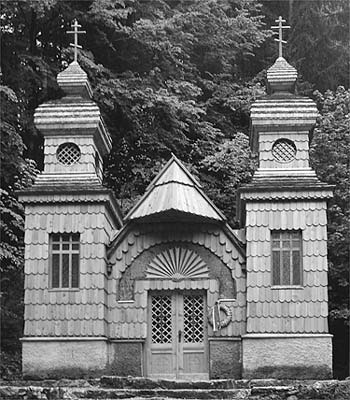
Back on the road, after #17, look as high as you can on the cliff face to see sunlight streaming through a “window” in the rock. This natural formation, a popular destination for intrepid hikers, is big enough for the Statue of Liberty to crawl through.
After #22, at the pullout for Erjavčeva Koča restaurant, you may see tour-bus groups making a fuss about the mountain vista. They’re looking for a ghostly face in the cliff wall, supposedly belonging to the mythical figure Ajda. This village girl was cursed by the townspeople after correctly predicting the death of the Zlatorog (Golden Horn), a magical, beloved, chamois-like animal. Her tiny image (with a Picasso nose) is just above the tree line, a little to the right—try to get someone to point her out to you (you can see her best if you stand at the signpost near the road).
After #24, you reach the summit (5,285 feet). Consider getting out of the car to enjoy the views (in peak season, you’ll pay an attendant a €3.50 “ecological tax” to park here). Hike up to the hut for a snack or drink on the grand view terrace. On the right, a long gravel chute gives hikers a thrilling glissade. (From the pullout just beyond #26, it’s easy to view hikers “skiing” down.) If you have time and energy to burn, from the summit consider hiking about 20 minutes uphill to the Poštarski Dom (“Fifth Hut”). Along the way, you’ll see the ruins of a telpher cable-car line, which was used to run supplies between here and the valley floor during World War I. You’ll also enjoy some of the best possible views of the Ajda face.
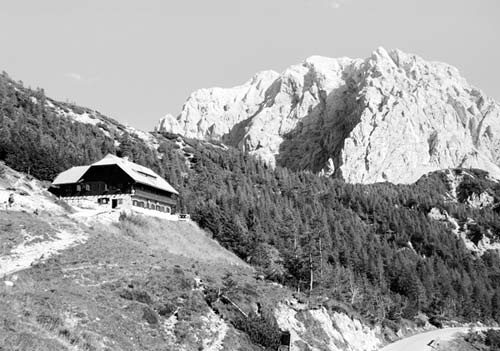
As you begin the descent, keep an eye out for old WWI debris. A lonely guard tunnel stands after #28, followed by a tunnel marked 1916 (on the left) that was part of the road’s original path. Just after, watch for the turnoff at the right, at a little gravel parking lot with a picnic table. From the platform viewpoint, you can see mountain valleys formed in two different ways: To the left, the jagged V-shaped Soča Valley, carved by a raging river; and on the right, the gentle U-shaped Trenta Valley, gouged by a glacier.
Continuing down, you’ll see abandoned checkpoints from when this was the border between Italy and the Austro-Hungarian Empire. At #48 is a statue of Julius Kugy, an Italian botanist who wrote books about alpine flora.
At #49, the road to the right (marked Izvir Soče) leads to the source of the Soča River. If you feel like stretching your legs after all that shifting, drive about five minutes down this road to a restaurant parking lot. From here, you can take a challenging 20-minute uphill hike (which includes some stretches where you’ll cling to guide wires) to the Soča source. This is also the starting point for the well-explained, 12-mile Soča Trail (Soška Pot), which leads all the way to the town of Bovec, mostly following the road we’re driving on today.
Nearing the end of the switchbacks, follow signs for Bovec. Crossing the Soča River, you begin the second half of this trip.
(See “The Julian Alps & Northwest Slovenia” map, here.)
During World War I, the terrain between here and the Adriatic made up the Soča (Isonzo) Front. As you follow the Soča River south, down what’s nicknamed the “Valley of the Cemeteries,” the scenic mountainsides around you tell the tale of this terrible warfare. Imagine a young Ernest Hemingway driving his ambulance through these same hills (see sidebar).
But it’s not all so gloomy. There are plenty of other diversions—interesting villages and churches, waterfalls and suspension bridges, and lots more. Perhaps most impressive is the remarkable clarity and milky-blue color of the Soča itself, which Slovenes proudly call their “emerald river.”
After switchback #49, you’ll cross a bridge, then pass a church and a botanical garden of alpine plants (Alpinum Juliana). Across the street from the garden (on the right) is the parking lot for the Mlinarica Gorge. While the gorge is interesting, the bridge leading to it was damaged in a severe storm and hasn’t yet been rebuilt—so it’s best left to hardy hikers.
The last Vršič switchback (#50) sends you into the village of Trenta. As you get to the cluster of buildings in Trenta’s “downtown,” look on the left for the Triglav National Park Information Center, which also serves as a regional TI (daily July-Aug 8:00-20:00, May-June and Sept-Oct 10:00-18:00, Dec-April 10:00-14:00, closed Nov, tel. 05/388-9330, www.tnp.si). The €5 museum here provides a look (with English explanations) at the park’s flora, fauna, traditional culture, and mountaineering history. An AV show celebrates the region’s forests, and a poetic 15-minute slideshow explains the wonders and fragility of the park (included in museum entry, ask for English version as you enter).
After Trenta, you’ll pass through a tunnel; then, on the left, look for a classic suspension bridge. Pull over to walk out for a bounce, enjoying the river’s crystal-clear water and the spectacular mountain panorama.
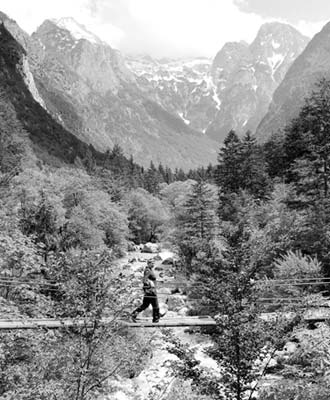
About five miles beyond Trenta, in the town of Soča, is the Church of St. Joseph (with red onion dome, tucked behind the big tree on the right). Step inside to see some fascinating art. During World War II, an artist hiding out in the mountains filled this church with patriotic symbolism. The interior is bathed in Yugoslav red, white, and blue—a brave statement made when such nationalistic sentiments were dangerous. On the ceiling is St. Michael (clad in Yugoslav colors) with Yugoslavia’s three WWII enemies at his feet: the eagle (Germany), the wolf (Italy), and the serpent (Japan). The tops of the walls along the nave are lined with saints, but these are Slavic, not Catholic. Finally, look carefully at the Stations of the Cross and find the faces of hated Yugoslav enemies: a lederhosen-clad Hitler (pulling a rope to upright the cross; fourth from altar on left) and Mussolini (seated, as Herod; first from altar on right). Behind the church, the stylized cross on the hill marks a WWI cemetery—the final resting place of some 600 Austro-Hungarian soldiers who were killed in action.
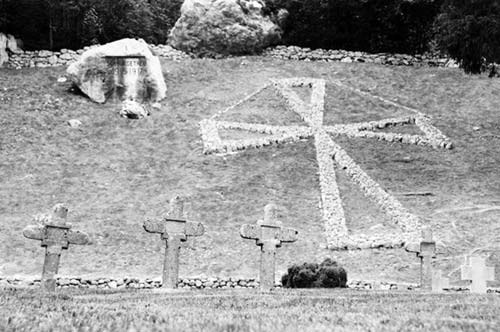
For another good example of how the Soča River cuts like God’s band saw into the land, stop about two minutes past the church at the small gravel lot (on the left) marked Velika Korita Soče (“Grand Canyon of Soča”). While the entire Soča Valley is dramatic, this half-mile, 30- to 50-foot deep stretch is considered the most impressive. Venture out onto the suspension bridge over the gorge...and bounce if you dare. If the water’s high, notice the many side streams pouring into the churning river in a series of mini-waterfalls. For more views, cross over the bridge and hike down along the treacherously uneven and narrow, rocky path downstream to another bridge.
Just beyond the suspension bridge is the turnoff (on the left) to the Lepena Valley, home of the recommended Pristava Lepena ranch, with accommodations and Lipizzaner horses (described later, under “Sleeping in Bovec”). If you head up this valley, you’ll find a big, gravel pullout on the right (marked Velika Korita) that lets you cross another springy bridge over a particularly wide stretch of the river. This is a popular place for those who enjoy hiking up alongside the “Grand Canyon” we passed earlier (about 5 miles round-trip, uneven terrain).
Soon after the Lepena Valley turn-off, watch on the left for the large barn (marked Žičnica Golobar). Pull over here if you’d like a close look at one of the stations for a primitive, industrial telpher cable-car line, which was used mostly for logging.
Roughly five miles after the town of Soča, you exit the national park, pass a WWI graveyard (on the left), and come to a fork in the road. The main route leads to the left, through Bovec. But first, take a two-mile detour to the right (marked Trbiž/Tarvisio and Predel/Kluže), where the WWI Kluže Fort keeps a close watch over the narrowest part of a valley leading to Italy (€3; July-Aug daily 9:00-20:00; June and Sept Sun-Fri 9:00-17:00, Sat 9:00-18:00; May and Oct Sat-Sun 10:00-17:00, closed Mon-Fri; closed Nov-April; www.kluze.net). In the 15th century, the Italians had a fort here to defend against the Ottomans. Half a millennium later, during World War I, it was used by Austrians to keep Italians out of their territory. Notice the ladder rungs fixed to the cliff face across the road from the fort—allowing soldiers to quickly get up to the mountaintop.
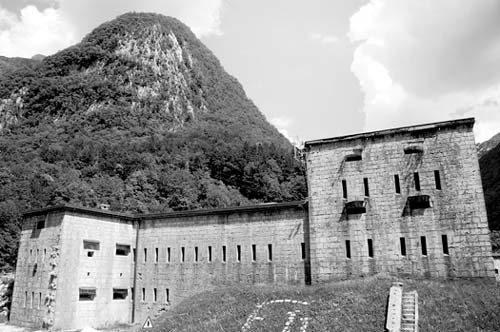
Back on the main road, immediately after the Kluže turnoff, watch for the gravel pullout on the left with the little wooden hut (look for the green sign with old photos). If you’d like to see some original WWI-era fortifications, pull over here and hike on the gravel path 10 minutes through the woods to reach the Ravelnik Outdoor Museum. Here you can see trenches dug into the dirt and rocks, abandoned pillboxes, rusty sheds, and other features of an evocative wartime landscape. While not entirely typical of Soča Front embattlements (remember, those were mostly high on the mountaintops and remain challenging to reach), Ravelnik offers a taste of those times.
Continue following the main road to Bovec. This town, which saw some of the most vicious fighting of the Soča Front, was hit hard by earthquakes in 1994 and 1998 (and by another tremor in 2004). Today, it’s been rebuilt and remains the adventure-sports capital of the Soča River Valley—also known as the “Adrenaline Valley,” famous for its whitewater activities. (Since the water comes from high-mountain runoff, the temperature of the Soča never goes above 68 degrees Fahrenheit.) For a good lunch stop in Bovec, turn right at the roundabout as you first reach the town; you’ll pass Martinov Hram’s inviting restaurant terrace on the right, and soon after, the Letni Vrt pizzeria (for details on both, see “Eating in Bovec,” later). But if you’re not eating or spending the night in Bovec, you could skip the town entirely and not miss much (continue along the main road to bypass the town center).
About three miles past Bovec, as you cross the bridge (with the yellow Boka sign), look carefully high up on the rock wall in the gorge to your right to spot the Boka waterfall, which carves a deep gouge into the cliff as it tumbles into the valley. (Hardy hikers can climb up for a better view of this fall—the trailhead is just after the bridge on the right—but it’s an extremely strenuous hike.)
Head south along the river, with water somehow both perfectly clear and spectacularly turquoise. When you pass the intersection at the humble village of Žaga, you’re just four miles from Italy. Continuing south, you’ll pass a pullout (just before Srpenica) that is a popular put-in point for kayaking trips along the river. Keep an eye out for happy kayakers. Soon after, on the left, you’ll pass the giant TKK factory (which makes caulk and other building materials).
Soon you’ll see signs for Kobarid, home to a sleepy main square and some fascinating WWI sights. Don’t blink or you’ll miss the Kobarid turnoff on the right—it lets you skirt into town past the highly recommended Kobarid Museum, which tells the tale of the WWI-era Soča Front. Farther along, you’ll reach the tidy main square. Driving up to the Italian mausoleum hovering over the town is a must. (These sights are described later, under “Sights in Kobarid.”)
Leaving Kobarid, continue south along the Soča to Tolmin. Before you reach Tolmin, decide on your preferred route back to civilization...
(See “The Julian Alps & Northwest Slovenia” map, here.)
While you could go back over the pass the way you came, there are various ways to make your trip a loop by circling through some more varied scenery. Which way you go depends on your final destination: Ljubljana or Bled.
From Tolmin, you have two possible driving routes to the capital. Either option brings you back to the A-1 expressway south of Ljubljana, and will get you to the city in about two hours (though the second route has fewer miles).
Nova Gorica Route: The option you’ll encounter first (turnoff to the right before Tolmin) is the smoother, longer route southwest to Nova Gorica. Along this road, you’ll pass a hydroelectric dam and go under a 1906 rail viaduct that once connected this area to the port of Trieste (now in Italy). In the charming town of Kanal, you’ll cross over the Soča on a picturesque bridge that’s faintly reminiscent of Mostar’s (as in that city, young people stage a competition that involves jumping off this bridge into the raging river below). Farther along, the striking Solkan Bridge (another link in the Trieste rail line) is the longest single-span stone arch bridge in the world. Soon after, you arrive in Nova Gorica. This fairly dull city is divided in half by the Italian border (the Italian side is called “Gorizia”). Because Italians aren’t allowed to gamble in their home towns, Nova Gorica is packed with casinos catering to Italian gamblers. In fact, it’s home to Europe’s biggest casino. Rocks spell out the name “TITO” on a hillside above town—a strange relic of an earlier age. From Nova Gorica, you can hop on the H-4 expressway, which links easily to the main A-1 expressway. Also notice that the road from Nova Gorica to Ljubljana takes you through the heart of the Karst region—if you have time and daylight to spare, you could tour a cave, castle, or Lipizzaner stud farm on your way back up to Ljubljana (see the Karst chapter).
Idrija Route: For a more off-the-beaten-path, ruggedly scenic approach, take this rural option: Continue through Tolmin, then head southeast through the hills back toward Ljubljana. Along the way, you could stop for a bite and some sightseeing at the town of Idrija (EE-dree-yah), known to all Slovenes for three things: its tourable mercury mine, fine delicate lace, and tasty žlikrofi (like ravioli). Back at the expressway (at Logatec), head north to Ljubljana.
To reach Bled, you could follow either of the Ljubljana-bound routes outlined above, then carry on northward for another hour to Bled (allow about 3 hours total). But the following options are more direct.
Car Train: The fastest option is to load your car onto a “Car Train” (Autovlak) that cuts directly through the mountains. The train departs at 18:31 from Most na Soči (just south of Tolmin, along the Idrija route described above) and arrives at Bohinjska Bistrica, near Lake Bohinj, at 19:14 (€12 for the car; afternoon departure May-Sept only, also departs year-round at 7:34 and 10:27, confirm schedule at the Bled TI before making the trip). No reservations are necessary, but arrive at the train station about 30 minutes before the scheduled departure to allow time to load the car. Note: This is a very old train that can be quite jerky and bumpy. You’ll stay inside your car the entire time. If you’re claustrophobic, prone to motion sickness, or both, consider giving this train a miss.
To get to the car train, drive though Tolmin, then Most na Soči (turning left for Ljubljana). About a mile out of Most na Soči, watch on the right for the big bridge over the river, marked for Čepovan and železniška postaja (train station). Crossing the bridge, turn right to find the train station; once there, go around the far-left side of the long station building and drive up the ramp to wait your turn to load. You’ll buy your ticket, make a sharp turn to pull onto the train car, creep up until they tell you to stop, kill the engine, pull your hand brake, and put the car in gear. Then you’ll stay in the car and enjoy the scenery. Taking off, you’ll cross a scenic viaduct, then twist through the mountains, going through multiple tunnels including a final 10-minute passage from Podbrdo beneath the mountains to Bohinjska Bistrica, where you’ll unload your car. From Bohinjska Bistrica, it’s just a half-hour drive back to Bled, or a 10-minute drive (in the opposite direction) to Lake Bohinj.
Through Italy via Predel Pass: Although this route requires some backtracking, it also includes a detour through Italy. From Kobarid, drive back the way you came (through Bovec), then turn off for the Kluže Fort (described on here), marked for Predel and Italy. In a few miles, after passing the fort, the road curves up through two small villages (first Log pod Mangartom, then Strmec na Predelu directly above it). Continue past the ruined fortress and cross the Italian border (there’s no need to stop). Then curl down a few hairpin turns past the end of tranquil, scenic Lake Predel, and continue straight through the ghost city of Cave del Predil (a heavily industrialized former lead-mining town; overhead are the five rounded peaks of the Cinque Punte formation) and along the valley road, following signs for Slovenia. Approaching Tarvisio, turn right (continuing to follow signs for Kranjska Gora and Slovenia); from here, it’s about a half-hour (10 miles) back across the Slovenian border to Kranjska Gora. This is where you first began your ascent of the Vršič Pass—just retrace your steps back to Bled.
Other Driving Routes: The fastest route (about 2 hours) essentially follows the car train route, but goes over rather than through the mountains. This route is partially on a twisty, rough, very poor-quality road (go through Tolmin, turn off at Bača pri Modreju to Podbrdo, then from Petrovo Brdo take a very curvy road through the mountains into Bohinjska Bistrica and on to Bled). For timid drivers, it’s more sane and not too much longer to start out on the Idrija route toward Ljubljana (described above), but turn off in Želin (before Idrija) toward Skofja Loka and Kranj, then continue on to Bled.
The biggest town in the area, Bovec (BOH-vets) has a happening main square and all the tourist amenities. It’s best known as a hub for whitewater adventure sports. While not exactly quaint, Bovec is charming enough to qualify as a good lunch stop or overnight home base. If nothing else, it’s a nice jolt of civilization wedged between the alpine cliffs.
The helpful TI on the main square offers a town map and brochure, fliers on mountain biking and water sports, and hiking and rafting maps (June-Sept daily 8:30-20:30, Oct-May daily 9:00-12:00 & 14:00-17:00 except closed Sat-Sun in Nov-April, Trg Golobarskih Žrtev 8, tel. 05/384-1919, www.bovec.si).
The main road skirts Bovec, but you can turn off (watch for signs on the right) to take the road that goes through the heart of town, then rejoins the main road farther along. As you approach the city center, you can’t miss the main square, Trg Golobarskih Žrtev, with the TI and a good restaurant (described later, under “Eating in Bovec”). You’ll find a big, free parking lot behind the Mercator supermarket (on the left on the way into town, just before the main square), and a few pay parking spaces on or near the square itself.
As the de facto capital of Slovenia’s “Adrenaline Valley,” there are many opportunities to enjoy the nature all around Bovec.
The main activity in the Soča Valley is getting out on the rushing, crystal-clear waters of the river. The main options are rafting, kayaking, and hydrospeeding (a masochistic variation on boogie boarding—lying face-down on a short surfboard, and shooting headfirst toward the rapids). The official season is March 15 until October 31, but outside of summer, the frigid water is less appealing and fewer companies operate. From an adrenaline perspective, these activities are best in spring—when the water is highest—and tamer in summer. By fall, water levels are even lower.
When conditions are ideal, most rafting companies put in near the Boka waterfall (just downriver from Bovec), and pick up at the village of Trnovo ob Soči. (When water levels are low, companies put in near Sprenica instead.) Most rafting trips last about 2.5-3 hours, with about 1.5 hours actually on the river, and extra time to swim.
Kayaking is available at various points along the river, which vary dramatically in difficulty; the TI’s free Water-Adventure-Sport map outlines your options, and notes areas that are unsafe. To get a glimpse of kayakers, hang out at Napoleon Bridge, just outside of Kobarid.
The most popular place for canyoning—a risky activity that involves wading and rappelling in rushing rivers—is in Canyon Sušec, about halfway between Bovec and Kobarid.
Other popular options include skydiving and paragliding; biking (Bovec Šport Centar rents electric mountain bikes); ziplines (there’s a course above Bovec, and another high in the Učja Valley); and even—gasp!—golf (Bovec has a 9-hole course, www.golfbovec.si). Of course, all of these activities come with some degree of risk (except, perhaps, golf); use common sense and investigate the safety record of any company that offers trips. The Bovec TI is a good source of information about any of these, and an ever-changing roster of local adventure travel companies run a variety of tours. Well-established outfits include Bovec Šport Centar (www.bovec-sc.si) and Soča Rafting (www.socarafting.si).
Aero Taxi runs scenic sightseeing flights from Bovec’s little airport (€40/8-minute flight to Boka waterfall and back, €90/20-minute flight to Mount Krn, €140/35-minute flight over Mount Triglav, prices are for up to 3 people, mobile 041-262-726, www.janezlet.si).
The Soča River is a popular spot for fishing, predominantly for the endemic marble trout. Only fly fishing is allowed; some areas are catch-and-release, and all areas require a permit. Soča Fly offers information, fly-fishing gear, and tours (www.socafly.com).
Dobra Vila, Hotel Sanje ob Soči, and Hotel Mangart are all situated near the turnoff from the main road into central Bovec (about a 10-minute walk into town). Martinov Hram and Stari Kovač are closer to the main square, in the town center.
$$$ Dobra Vila, run with class by brothers Juri and Matjaš, has 11 plush, boldly stylish, yet classic rooms in a gorgeously restored former telephone office that feels like an enticing whisper of ages past (Db-€120-145 depending on size and amenities, cheaper off-season, air-con, free Wi-Fi, Mala vas 112, tel. 05/389-6400, www.dobra-vila-bovec.si, welcome@dobra-vila-bovec.si). They also have the most elegant restaurant in town (€30 dinner for guests; see “Eating in Bovec,” later).
$$$ Hotel Sanje ob Soči means “Dreams by the Soča”—which describes both what you’ll do here, and the vision that entrepreneurial owners Boštjan and Valentina have for their sleek, modern, spa-like lodgings. The 10 rooms (Db-€98-124, includes breakfast) and nine apartments (€110-180, include kitchenettes, optional breakfast-€8 extra) fill a pine-clad, Scandinavian-feeling shell on the edge of Bovec. The rooms—all with terraces, and each one named for the mountain that dominates its view—are fairly simple and Ikea-furnished (price depends on size, 20 percent cheaper in spring and fall, air-con, free Wi-Fi, children’s play area, Mala vas 105a, tel. 05/389-6000, mobile 031-331-690, www.sanjeobsoci.com, info@sanjeobsoci.com).
$$$ Hotel Mangart is a big, modern, somewhat overpriced chalet-style hotel with 36 rooms on the edge of Bovec (toward the Vršič Pass). All of the rooms have balconies, except the cheaper bunk-bed hostel rooms (Db-€100 in July-Aug, €90 in May-June and Sept, €80 in Oct-May, bigger superior rooms have bathtubs and nicer decor—not worth the extra €20; hostel rooms are a great value-€25/person in a small 2-, 4-, or 6-bed room with a tight bathroom; elevator, free Wi-Fi, sauna and massage for an extra fee, sprawling basement pub, Mala vas 107, tel. 05/388-4250, www.hotel-mangart.com, booking@hotel-mangart.com).
$$ Martinov Hram has 12 nice, modern rooms over a popular restaurant a few steps from Bovec’s main square. While the rooms are an afterthought to the busy restaurant (reception at the bar), they’re comfortable (very flexible rates, in peak season figure Sb-€40, Db-€70, a few euros less off-season, no extra charge for 1-night stays, rooms on sunny side have air-con, free Wi-Fi, Trg Golobarskih Žrtev 27, tel. 05/388-6214, www.martinov-hram.si, sara.berginc@gmail.com).
$ Stari Kovač B&B is your basic budget option, with eight rooms in an old-feeling guest house a steep block downhill from the main square (Db-€48, cheaper off-season and for 3 nights or more, kitchens in each room or pay €6/person for breakfast, cash only, free Wi-Fi, Rupa 3, tel. 05/388-6699, mobile 041-646-427, www.starikovac.com, info@starikovac.com).
$$$ Pristava Lepena is a relaxing oasis hiding out in the Lepena Valley just north of Bovec. Well-run by Milan and Silvia Dolenc, this place is its own little village, with a series of rustic-looking cabins, a restaurant, a small exercise room, a kids’ play area, a tennis court, an outdoor swimming pool, and a sauna/whirlpool. Milan and Silvia organize regular events for their guests (such as musical performances, a barbecue night, and activities for kids). Hiding behind the humble split-wood shingle exteriors is surprising comfort: 13 cozy rooms (with wood-burning stoves, TV, telephone, free Wi-Fi, and all the amenities) that make you feel like relaxing. This place whispers “second honeymoon” (Db-€138 in July-Aug, €122 in May-June and Sept, €106 in early Oct and late April, more for larger apartments, closed in winter except mid-Dec-early Jan, multinight stays preferred, single-night stays may be possible for 20 percent extra, dinner-€23, lunch and dinner-€35, nonrefundable 30 percent advance payment when you reserve; just south of the village of Soča, turn left off the main road toward Lepena, and follow the white horses to Lepena 2; tel. 05/388-9900, mobile 041-671-981, www.pristava-lepena.com, pristava.lepena@siol.net). The Dolences also have three Welsh ponies and five purebred Lipizzaner horses (two mares, three geldings) that guests can ride (experienced riders-€20/hour, riding lesson-€24; non-guests may be able to ride for a few euros more—call ahead and ask). Kids love their mascot mountain goats.
$$ Boka Pension fills a big, modern-but-tasteful building squeezed between the road and the Soča, near the big Boka waterfall. The 20 rooms are simple but have nice woody touches (Db-€86 in mid-July-Aug, €74 in May-mid-July and Sept, cheaper off-season, €10 more for bigger suite with balcony, some road noise, air-con, elevator, free cable Internet in rooms, free Wi-Fi in lobby, Žaga 156a, tel. 05/384-5512, www.boka-bovec.si, penzion@boka-bovec.si).
$ Tourist Farm Pri Plajerju is on a picturesque plateau at the edge of Trenta (the first town at the bottom of the Vršič Pass road). Run by the Pretner family (gregarious Marko is a park ranger, shy Stanka is “the boss”), this organic farm raises sheep and rents five apartments in three buildings separate from the main house. As the Soča Valley doesn’t have many tourist farms, this is one of your best options if you want to stay at one. However, its location deeper in the mountains makes it a bit less convenient for side-tripping—it’s 30 minutes to Bovec, and an hour to Kobarid (July-Aug: Db-€45-55, Tb-€55-65, Qb-€68-78; Sept-June: Db-€40-50, Tb-€50-60, Qb-€63-70; price depends on size, breakfast-€7, dinner-€11—available some but not all nights; watch for signs to the left after coming over the pass and going through the village of Trenta, Trenta 16a; tel. 05/388-9209, mobile 041-600-590, www.eko-plajer.com, info@eko-plajer.com).
Inexplicably, little Bovec’s restaurants tend to charge a cover of €1-1.50—a greedy practice otherwise rare in Slovenia, but perhaps influenced by the town’s proximity to Italy.
Martinov Hram, run by the Berginc family, has an inviting outdoor terrace under a grape trellis. Inside, the nicely traditional decor goes well with regional specialties with a focus on sheep (good homemade bread, €7-12 pastas, €8-20 main courses, daily 10:00-23:00 except closed Mon in Oct-May; on the main road through Bovec, just before the main square on the right at Trg Golobarskih Žrtev 27; tel. 05/388-6214).
Letni Vrt is big, with an outdoor terrace facing Bovec’s main intersection, and sprawling indoor dining rooms—including a nice winter garden that’s inviting on cold days. The menu is, likewise, almost comically lengthy—I’d stick with the good and affordable pizzas (€7-11 pizzas and pastas, €9-20 main dishes, daily 11:00-23:00, Fri-Sun only in winter, Trg Golobarskih Žrtev 1, tel. 05/389-6383).
Dobra Vila, also a recommended hotel, is the only place in town for an elegant, upscale meal of thoughtfully presented international cuisine with local flair. It’s smart to call ahead (€36 fixed-price dinner for non-guests, daily 19:00-22:00, see contact information earlier).
From Bovec by Bus to: Kobarid (4-6 day, 30 minutes), Ljubljana (direct over scenic Vršič Pass: 2/day July-Aug, 1/day Sat-Sun only June and Sept, none off-season, 4.25 hours; some additional buses may go over Vršič Pass to Kranjska Gora, where you can change to other destinations; otherwise less scenic via Idrija).
Kobarid (KOH-bah-reed) feels older, and therefore a bit more appealing, than its big brother Bovec. This humble settlement was immortalized by a literary giant, Ernest Hemingway, who drove an ambulance in these mountains during World War I. He described Kobarid as “a little white town with a campanile in a valley. It was a clean little town and there was a fine fountain in the square.” Sounds about right. Even though Kobarid loves to tout its Hemingway connection, historians believe that Papa did not actually visit Kobarid until he came back after the war to research his book.
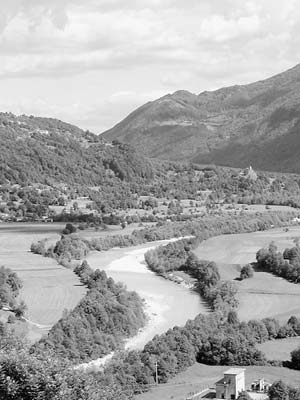
Aside from its brush with literary greatness, Kobarid is known as a hub of information about the Soča Front (with an excellent WWI museum, a hilltop Italian mausoleum, and walks that connect to surrounding sites). You won’t find the fountain Hemingway wrote about—it’s since been covered up by houses (though the town government hopes to excavate it as a tourist attraction). You will find a modern statue of Simon Gregorčič (overlooking the main intersection), the beloved Slovenian priest-slash-poet who came from and wrote about the Soča Valley.
The main road cuts right through the heart of little Kobarid, bisecting its main square (Trg Svobode). The Kobarid Museum is along this road, on the left before the square. To reach the museum from the main square, simply walk five minutes back toward Bovec.
The TI has good information on the area, and free Internet access and Wi-Fi (May-June Mon-Fri 9:00-13:00 & 14:00-18:00, Sat-Sun 10:00-14:00; July-Sept daily 9:00-19:00, until 20:00 in Aug; Oct-April Mon-Fri 9:00-13:00 & 14:00-16:00, Sat 10:00-14:00, closed Sun; on the main square at Trg Svobode 16—follow the white footprints behind the statue of Gregorčič, tel. 05/380-0490, www.dolina-soce.com).
Driving into town from Bovec, watch carefully on the right for the poorly marked first turnoff into Kobarid (they want you to stay on the main road bypass around town; if you miss the turnoff, just continue on this, then turn right later to reach the main square). Turning into town, you could make a sharp left turn to reach the cheese factory (marked by the big, modern tower), or continue straight ahead to pass the Kobarid Museum, then the main square. You’ll find parking on the main square (free for up to 2 hours), from which it’s an easy five-minute stroll to the museum.
This modest but world-class museum—worth ▲▲▲ for history buffs—offers a haunting look at the tragedy of the Soča Front. The tasteful exhibits, with fine English descriptions and a pacifist tone, take an even-handed approach to the fighting—without getting hung up on identifying the “good guys” and the “bad guys.” The museum’s focus is not on the guns and heroes, but on the big picture of the front and on the stories of the common people who fought and died here.
Cost and Hours: €6, good selection of books; April-Sept Mon-Fri 9:00-18:00, Sat-Sun 9:00-19:00; Oct-March Mon-Fri 10:00-17:00, Sat-Sun 9:00-18:00; Gregorčičeva 10, tel. 05/389-0000, www.kobariski-muzej.si.
Tours: History buffs can call ahead to arrange a private guide to lead them through the collection (€20/hour), or tour the sights outside (€25/hour). You can also arrange a guide through the Walk of Peace Visitors Center, listed later.
Visiting the Museum: The entry is lined with hastily made cement and barbed-wire gravestones, flags representing all the nationalities involved in the fighting, and pictures of soldiers and nurses from diverse backgrounds who were brought together here (for example, the men wearing fezzes were from Bosnia-Herzegovina, which was annexed by the Austro-Hungarian Empire shortly before the war). The rooms in this front part of the museum show off typically good temporary exhibits about the war.
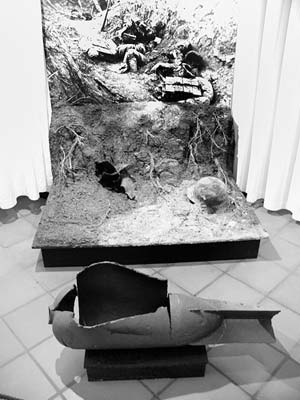
Buy your ticket and ask to watch the English version of the 19-minute film on the history of the Soča Front (informative but dry, plays on top floor).
The first floor up is divided into several rooms, which you’ll tour counterclockwise. The White Room, filled with rusty crampons, wire-cutters, pickaxes, and shovels, explains wintertime conditions at the front. What looks like a bear trap was actually used to trap enemy soldiers. The Room of the Rear shows the day-to-day activities away from the front line, from supplying troops to more mundane activities (milking cows, washing clothes, getting a shave, lifting weights, playing with a dog). The Black Room is the museum’s most somber, commemorating the more than one million casualties of the Soča Front. These heartbreaking exhibits honor the common people whose bodies fertilized the battlefields of Europe. Horrific images of war injuries are juxtaposed with a display of medals earned—prompting the question, was it worth it? The little altar was purchased by schoolchildren, who sent it to the front to offer the troops some solace.
Through the door marked The Krn Range Room (also on the first floor up), pass the small model of the mountaintop war zone and find your way to the Kobarid Rooms, which trace the history of this region from antiquity to today. High on the wall, look for the timelines explaining the area’s turbulent past. The one in the second room shows wave after wave of invaders (including Ottomans, Habsburgs, and Napoleon). In the next room, above a display case with military uniforms, another timeline shows the many flags that flew over Kobarid’s main square during the 20th century alone.
On the top floor, across from the room where the film plays (described above), you’ll see a giant model of the surrounding mountains, painstakingly tracing the successful Austrian-German Blitzkrieg attack during the Battle of Kobarid. Crawl into the small cave and press the button to hear a patriotic song about a soldier, who reads a letter he’s written to his family about the conditions here.
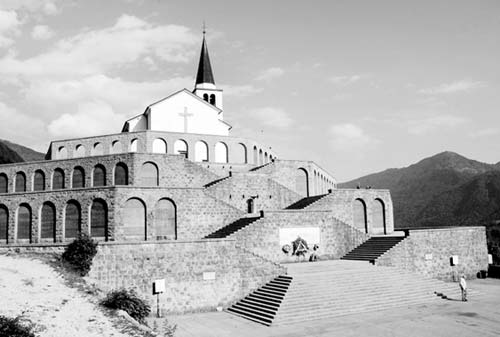
The 55 miles between here and the Adriatic are dotted with more than 75 cemeteries, reminders of the countless casualties of the Soča Front. One of the most dramatic is this mausoleum, overlooking Kobarid. The access road, across Kobarid’s main square from the side of the church, is marked by stone gate towers (with the word Kostnica—one tower is topped with a cross and the other with a star for the Italian army).
Take the road up Gradič Hill—passing Stations of the Cross—to the mausoleum. Built in 1938 (when this was still part of Italy) around the existing Church of St. Anthony, this octagonal pyramid holds the remains of 7,014 Italian soldiers. The stark, cold, Neoclassical architecture is pure Mussolini. Names are listed alphabetically, along with mass graves for more than 1,700 unknown soldiers (militi ignoti).
Walk behind the church and enjoy the view. Scan the WWI battlements high on the mountain’s rock face. Incredibly, the fighting was done on these treacherous ridges; civilians in the valleys only heard the distant battles. Looking up and down the valley, notice the “signal churches” evenly spaced on hilltops, each barely within view of the next—an ancient method for quickly spreading messages or warnings across long distances.
If the church is open, go inside and look above the door to see a brave soldier standing over the body of a fallen comrade, fending off enemies with nothing but rocks.
When Mussolini came to dedicate the mausoleum, local revolutionaries plotted an assassination attempt that they believed couldn’t fail. A young man planned to suicide-bomb Mussolini as the leader came back into town from this hilltop. But as Mussolini’s car drove past, the would-be assassin looked at his fellow townspeople around him, realized the innocent blood he would also spill, and had a last-minute change of heart. Mussolini’s trip was uneventful, and fascism continued to thrive in Italy.
This walking route—which, as of a 2012 expansion, extends more than 140 miles from these mountains all the way to the Adriatic—is designed to link museums, cemeteries, churches, and other sites related to the warfare of the Soča Front. But it also has a secondary purpose of celebrating and introducing visitors to all aspects of regional culture and natural sites. In addition to the excellent museum here in Kobarid, several other “outdoor museums” in the area let you get close to the places where the fighting actually occurred. Some are reachable by car, while others require a challenging mountain hike.
To learn more about all of these options, visit the Walk of Peace Foundation Visitors Center, across the street from the Kobarid Museum. They hand out good, free maps and booklets about these sites, and sell a fine €10 guidebook to WWI sights in the area. Tour their engaging, state-of-the-art exhibition. To commemorate the centennial of the fighting here (2015-2017), they plan to host a range of rotating exhibits about the war (free, July-Aug Mon-Fri 9:00-13:00 & 14:00-19:00, Sat-Sun 10:00-13:00 & 14:00-19:00, April-June and Sept-Oct slightly shorter hours, closed Nov-March—but you can try knocking on weekdays, Gregorčičeva 8, tel. 05/389-0167, www.potmiru.si).
They also arrange guides to join you for part of the walk (€25/hour for up to 4 hours, €20/hour for longer tours), and in the summer, they offer excursions to related sights nearby (for example, to the open-air museum in Kolovrat, €15, 3-person minimum). Contact them at least one day ahead to check their schedule and/or arrange a tour.
This shorter walk to WWI sights around Kobarid is well-explained by the free brochure available at the TI, museum, and information center (3 miles, mostly uphill, allow 3-5 hours; or you can just do a shorter, easier stretch along the river, 1-2 hours).
This humble exhibit, at the big Planika (“Edelweiss”) dairy at the edge of town, examines the history of cheesemaking in this area since ancient times.
Cost and Hours: €2.50, April-Sept Mon-Sat 10:00-12:00 & 17:00-19:00; Oct Mon-Fri 9:00-12:00, Sat 10:00-12:00 & 16:00-18:00; closed Sun and Nov-March; Gregorčičeva 32, tel. 05/384-1013, www.mlekarna-planika.si/muzej. To get here, turn right into Kobarid, then take the sharp left turn that leads you down beneath the underpass to the cheese factory (marked by the tall modern tower).
If you have time to kill in Kobarid and want to go for a sturdy hike, consider trekking to the Great Kozjak Waterfall—a dramatic cascade that flows through an extremely narrow gorge and plunges 50 feet into a beautiful pool. While local signs clock the hike at 30 minutes from the town center, plan on closer to 45 minutes each way. The trailhead is at the Bovec end of Kobarid: As you approach the town from Bovec, turn right into the town, then take an immediate and sharp left to go back under the main road, passing the cheese factory and following signs for Kamp Koren. Wind down to cross the Napoleon Bridge over the Soča (watch for kayakers), then turn left and head up the hill (you’ll pass Kamp Koren). You can park in the big gravel lot across the street from the camp, or, to get closer to the trailhead, turn left just after Kamp Koren at the Slap Kozjak sign and follow the gravel road (park your car at the pullout after the multicolored beehives). Continue walking along the gravel path down into the ravine, passing views of a smaller waterfall. Go right at the fork, continue into the gorge, and take the high, narrow bridge over the stream (which has no railing—a little nerve-wracking for those afraid of heights). Finally, follow the boardwalk as it curls around a cliff for great views of the falls. A different, longer trail follows the Soča River Valley, eventually looping up and around to Kozjak.
My first listing is right on the main square. The other two hide on side streets about a block off the main road through town, between the museum and the main square (about a 3-minute walk to either).
$$$ Hotel Hvala is the only real hotel in town. Run by the Hvala family, its 32 contemporary rooms are comfortable, and the location can’t be beat. The mural on the wall in the elevator shaft tells the story of the Soča Valley as you go up toward the top floor (Sb-€76, Db-€112, €4 less/person off-season; cheaper third-floor “mansard” Sb-€45, Db-€70; pricier superior Db with air-con and sleek new decor-€135/€160/€200 depending on size; hotel closed parts of Feb and Nov, elevator, free guest computer and Wi-Fi, Trg Svobode 1, tel. 05/389-9300, www.hotelhvala.net, topli.val@siol.net).
$$ Apartmaji Pri Nas (“Our Place”) has six very stylish apartments in a pleasant suburban home along the main road that skirts the town center of Kobarid (Db-€70/€50-60, 2-night minimum, no breakfast but kitchens in each unit, air-con, free Wi-Fi, Goriška cesta 5, mobile 031-377-585, www.pri-nas.si, prinas.kobarid@gmail.com).
$ Hiša Sonca (“House of the Sun”), in a cheery, yellow family home along the main road, has two comfortable rooms (Db-€48, breakfast-€7, cash only, free Wi-Fi, 2 blocks from main square at Mučeniška 1, mobile 031-664-253, www.apartma-hisasonca.com, hisasonca@gmail.com).
$ Apartmaji Lia, run by sweet Alenka Likar, has four tidy apartments in two buildings in the town center (Db-€40, 1-night stay-€10 extra, extra adult-€20, kids under 15-€10, cash only, no breakfast, some rooms have air-con, free Wi-Fi, main house at Volaričeva 9, mobile 041-953-366, www.apartmaji-lia.si, apartmajilia@gmail.com).
One of my favorite Soča Valley accommodations hides in a tiny village a twisty 10-minute drive up into the mountains above Kobarid’s main square. $$ Tourist Farm Kranjc is a remote but scenic, well-run, working sheep farm with eight comfortable rooms and a huge, shared view terrace. While this farm—which feels traditional, but has modern style—is a bit less convenient to the sights, it’s ideal if you want to really feel like you’re huddled high in the mountains (Db-€56, bigger “superior” Db-€62, includes breakfast, €10-12 extra per person for dinner, 20 percent more for 1-night stays, 10 percent extra for 2-night stays, air-con in attic rooms only, free Wi-Fi, Koseč 9, tel. 05/3848562, mobile 041-946-088, www.turizem-kranjc.si, info@turizem-kranjc.si, Urška and the Kranjc family). It’s in the village of Koseč, above Kobarid. From Kobarid, leave town by crossing the Napoleon Bridge (toward Kamp Koren and Kozjak waterfall—see directions on previous page). Just after that bridge, turn left and twist up to Drežnica, where you’ll turn right to reach Koseč; once in the village, look for signs directing you up the steep road to the left.
Kobarid prides itself on its restaurants, hosting a few of the best-regarded eateries in the region. (And arguably the best of them all is Hiša Franko, just outside of town and described in the next section.) Kotlar and Topli Val serve up elegant, borderline-pretentious, overpriced, but generally good meals that are worth the splurge. Picerija Fedrig is your budget alternative.
Kotlar Restaurant, on the main square, has a classy interior that sprawls around the prow of a faux sailboat. The emphasis is on seafood and locally sourced meats (€10-13 pastas, €12-25 main dishes, Mon 18:00-23:00, Thu-Sun 12:00-15:00 & 18:00-22:00, closed Tue-Wed, Trg Svobode 11, tel. 05/389-1110, www.kotlar.si). Kotlar also rents rooms if you’re in a pinch (Db-€70).
Topli Val (“Heat Wave”), Hotel Hvala’s restaurant, is pricey but good, with a menu that emphasizes fish (€8-13 pastas, €9-22 main courses, lengthy list of Slovenian wines, daily 12:00-23:00, Trg Svobode 1, tel. 05/389-9300).
Picerija Fedrig serves up good €5-7 pizzas (Mon-Tue 17:00-22:00, Wed-Sun 12:00-22:00; off-season Thu-Fri 17:00-22:00, Sat-Sun 12:00-21:30, closed Mon-Wed; a block south of the main square at Volaričeva 11, tel. 05/389-0115).
$$$ Hiša Franko is a gourmet restaurant that also rents 13 rooms less than a five-minute drive outside of Kobarid. The modern-style rooms in the main building are upscale and comfortable, while the three rooms in the adjacent yellow house are much simpler, dated, and affordable (main-building Db-€135-148 depending on size and amenities, yellow-house Db-€90, includes breakfast, free Wi-Fi, bike rental-€7, Staro Selo 1, tel. 05/389-4120, www.hisafranko.com, info@hisafranko.com).
What brings most people here is the upscale restaurant, which combines Slovenian cuisine and ingredients with modern international influences to create a memorable, if pricey, meal (three courses-€38, five courses-€53, nine courses-€75, no à la carte). The dining room is spiffy but casual and unpretentious, and the service is attentive and welcoming. Reserve ahead, especially in summer (Tue-Fri 19:00-23:00, Sat 12:00-15:00 & 19:00-23:00, Sun 12:00-15:00, closed Mon).
Getting There: To reach Hiša Franko, leave Kobarid following signs for Italija and Robič on the pleasant tree-lined road, and look for the restaurant’s sign on the right.
From Kobarid by Bus to: Bovec (4-6/day, 30 minutes), Ljubljana (1/day in July-Aug over Vršič Pass, 5 hours; otherwise faster but less scenic via Idrija, 3.5 hours).